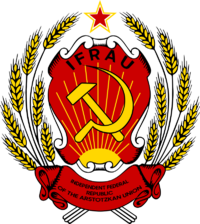Union Constitution Act 2024
| Union Constitution Act 2024 | |
|---|---|
 | |
| Third Session of the Federal Assembly | |
| An act to legislate the unification of the States, Territories (Domestic and Aboard), Administrative Regions and sovereign territory of the Independent Federal Republic of the Arstotzkan Union | |
| Territorial extent | Arstotzkan Union |
| Date enacted | 15 August 2024 |
| Date effective | 15 August 2024 |
| Legislative history | |
| Bill | 12 August 2024 |
| Related legislation | |
| Land and Territories Act 2023 | |
| Status: Current legislation | |
The Union Constitution Act 2024 is a significant piece of legislation in the Independent Federal Republic of the Arstotzkan Union, enacted to streamline and unify the administrative and territorial structure of the country. It repeals several prior legislative acts, including the Land and Territories Act 2023 and the Moutere Hapori Administrative Region Act 2023. It establishes a new framework for governing the nation's states, territories, and administrative regions.
Enacted on 15 August 2024, the Union Constitution Act 2024 aims to enhance administrative efficiency and coherence across the Arstotzkan Union.
Background
The division between the territories and the federal government has been the issue for several years. In 2020, during the transition to federalism, it became the biggest question to the new Arstotzkan Federal Government, what would be the policy with the territories. On 14 October, the Oversight Government for the Overseas Territories was formed along with the Land and Territories Act 2020. This formed the basis for relations between the territories and the federal government. However, in this relationship, the territories were more subservient and dependent on the territorial government than the federal government.
In 2022, relations grew closer as the federal government brought the states and territories closer. On 12 September 2022, the State Government of the Arstotzkan Union Proper and the Government of the United Territories were combined to form the Government of the Union.
Contents
Under the Act, five Union States are established, each defined by specific geographical locations. These states are Wairoa, covering territories north of the northern boundary of the Auckland Region; Hōrana, which includes territories on the North Island outside of Wairoa and Rangitaiki; Rangitaiki, encompassing territories in the Western Bay of Plenty District; Makariri, covering territories on the South Island of New Zealand; and the United Overseas Territories (Grondgebied), which includes all territories outside the New Zealand islands.
Each Union State will have a State Council composed of Territorial Commanders from the respective states. The number of seats in each State Council reflects the number of Territorial Commanders in the state. These councils are responsible for creating local legislation, managing natural resources, and implementing federal directives. A Council Chairman, elected every four years and subject to approval by the Office of the Presidency, will represent each State Council in the federal House of Representatives.
The Act underscores the supremacy of the Arstotzkan Federal Government over the Union States. State Councils are prohibited from overriding the Act or the Constitution, which remains the supreme law, amendable only by the Federal Assembly or the Office of the Presidency. The Constitution extends its powers to the Union States, affirming that no State Council can legislate on constitutional matters.
Federal Territories are defined as land areas of national significance, either inhabited or crucial for national security, and are to be governed by Territorial Commanders appointed by the First President. These Commanders oversee federal territories and ensure compliance with both federal and state directives.
The Act also addresses Autonomous Administrative Regions (AARs) by replacing previous legislation with new terms, maintaining their status under the authority of the Office of the Presidency. Additionally, the Act provides provisions for forming cities within Federal Territories. Federal Territories may establish cities if they meet specified size and population criteria and receive approval from the Office of the Presidency. Newly formed cities will have mayors with ceremonial roles, having no direct influence on state or territorial governance.
Lastly, the Act stipulates that it can be amended as necessary by the Office of the Presidency.